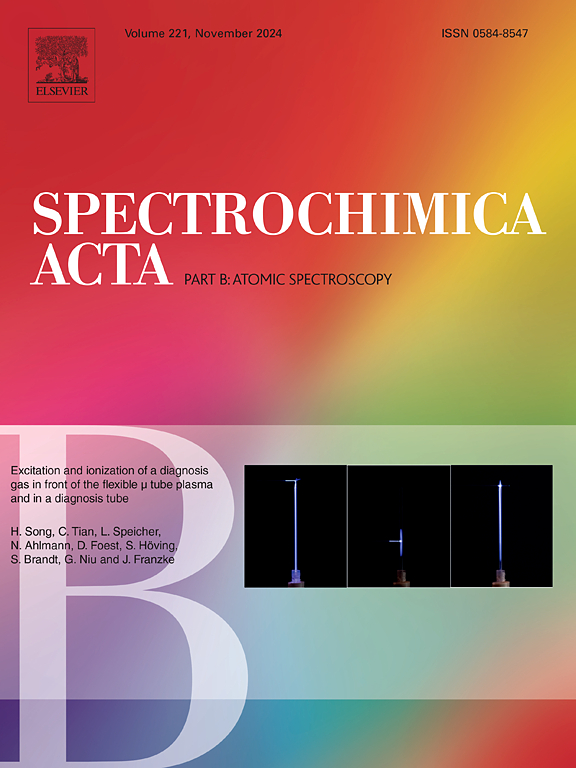Investigation of chromatographic procedures for the analysis of cationic impurities in uranium and plutonium matrices by ICP-OES and ICP-MS
IF 3.2
2区 化学
Q1 SPECTROSCOPY
引用次数: 0
Abstract
Four different separation protocols were tested to analyze several cations in a U-Pu matrix by inductively coupled plasma – optical emission spectrometry (ICP-OES) or mass spectrometry (ICP-MS): UTEVA resin with HNO3 eluent, UTEVA resin with HNO3/H2C2O4 eluent, UTEVA resin with HNO3/H2O2 eluent and TEVA resin with HNO3 eluent. It was shown that none of the twenty nine tested cations (Al, Ag, B, Ca, Cd, Ce, Cr, Cu, Fe, Ga, La, Mg, Mn, Mo, Na, Nd, Ni, Pb, Pd, Rh, Sb, Se, Si, Sn, Sr, Ti, V, Y and Zn) was retained onto the resin, with recovery yields between 80 and 120 %. Meanwhile, the U-Pu matrix was retained onto the resin and was eliminated from the fraction containing the cations. After initial testing, two of the protocols were chosen: UTEVA resin with HNO3/H2C2O4 eluent and UTEVA resin with HNO3/H2O2 eluent thanks to their efficacy and practicality. Then, the two selected protocols were applied to a uranium oxide certified reference material to validate them. Twenty three out of the thirty one impurities presents in the material (Ag, Ba, Be, Bi, Cd, Co, Cr, Cu, Dy, Eu, Fe, Gd, In, Li, Mo, Ni, Pb, Sm, Sn, Ti, V, W and Zr) were determined with good recoveries. Th was fixed onto the resin. Based on theses results, it seems possible to analyze the forty one impurities in a U-Pu material by optimizing the operating conditions. These two protocols were used to study the presence of impurities in a Pu-based material to ensure the purity of the materials. Detection limits in the order of μg g−1 powder were obtained.

求助全文
约1分钟内获得全文
求助全文
来源期刊
CiteScore
6.10
自引率
12.10%
发文量
173
审稿时长
81 days
期刊介绍:
Spectrochimica Acta Part B: Atomic Spectroscopy, is intended for the rapid publication of both original work and reviews in the following fields:
Atomic Emission (AES), Atomic Absorption (AAS) and Atomic Fluorescence (AFS) spectroscopy;
Mass Spectrometry (MS) for inorganic analysis covering Spark Source (SS-MS), Inductively Coupled Plasma (ICP-MS), Glow Discharge (GD-MS), and Secondary Ion Mass Spectrometry (SIMS).
Laser induced atomic spectroscopy for inorganic analysis, including non-linear optical laser spectroscopy, covering Laser Enhanced Ionization (LEI), Laser Induced Fluorescence (LIF), Resonance Ionization Spectroscopy (RIS) and Resonance Ionization Mass Spectrometry (RIMS); Laser Induced Breakdown Spectroscopy (LIBS); Cavity Ringdown Spectroscopy (CRDS), Laser Ablation Inductively Coupled Plasma Atomic Emission Spectroscopy (LA-ICP-AES) and Laser Ablation Inductively Coupled Plasma Mass Spectrometry (LA-ICP-MS).
X-ray spectrometry, X-ray Optics and Microanalysis, including X-ray fluorescence spectrometry (XRF) and related techniques, in particular Total-reflection X-ray Fluorescence Spectrometry (TXRF), and Synchrotron Radiation-excited Total reflection XRF (SR-TXRF).
Manuscripts dealing with (i) fundamentals, (ii) methodology development, (iii)instrumentation, and (iv) applications, can be submitted for publication.

 求助内容:
求助内容: 应助结果提醒方式:
应助结果提醒方式:


